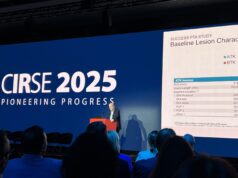
Early data from the first randomised controlled trial to compare two drug-coated balloons (DCBs) suggest that the primary patency obtained with the Ranger DCB (Boston Scientific) is “comparable” to that achieved with the IN.PACT DCB (Medtronic) in the treatment of superficial femoral artery lesions.
COMPARE 1 is an investigator-initiated trial that is funded by Boston Scientific and conducted at 15 German centres. Dierk Scheinert, principal investigator of the trial, presented the data at the Leipzig Interventional Course (LINC; 30 January–2 February, Leipzig, Germany).
“This is really the first randomised controlled trial which compares two different paclitaxel-coated balloons with different coating and paclitaxel dose density for the treatment of femoropopliteal disease,” said Scheinert who presented one-year data from the interim analysis of the trial.
While both Ranger and IN.PACT are coated with paclitaxel, the two devices used different doses of the antirestenotic drug. Ranger uses what is often described as a “low” paclitaxel dosing of 2μg/mm2, while IN.PACT Admiral uses a dose of 3.52μg/mm2 of the drug. The two DCBs also use different excipients; Ranger combines paclitaxel with a citrate ester excipient that is highly hydrophobic, while IN.PACT Admiral uses hydrophilic urea.
The first phase of COMPARE 1 was a pilot study involving 150 patients, before the investigating team secured funding for an extension that can involve up to 414 patients to test the non-inferiority hypothesis, Scheinert noted. Patients were stratified by lesion length into three groups and follow-up points were at six, 12 and 24 months. Scheinert noted that patient retention was “quite acceptable” at 12-months.
The study focused on patients with symptomatic peripheral arterial disease who are classified as being Rutherford class 2–4, with stenotic or occlusive lesions, de novo or restenotic lesions. The study excluded patients with in-stent restenosis and severe calcification. Investigators enrolled patients who had had no previous treatment with DCBs or drug-eluting stents in the treated limb and included patients with lesion lengths of up to 30cm.
In the pilot phase study, 150 patients were randomised to either receive treatment with the Ranger DCB (74 patients), or to receive treatment with an IN.PACT DCB (76 patients). The baseline patient demographics and lesion characteristics were well balanced between two groups. “This was a complex real world lesion subset with lesion length of around 12cm and around 40% chronic total occlusion. Bail out stent placement was 25% in both groups,” said Scheinert.
Primary endpoint
In the pilot, phase one cohort, the primary efficacy endpoint was patency rate at 12 months, which was defined as absence of clinically-driven target lesion revascularisation or restenosis evaluated by Duplex ultrasound. Kaplan-Meier estimates at one year showed that Ranger group had a primary patency rate of 84% and IN.PACT group had a primary patency of 89%. At the end of the follow-up window, pre-specified as ±45 days, the primary patency rate for the Ranger group was 84% compared to 62% in the IN.PACT group, which Scheinert clarified saying: “The standard deviation is bigger here due to the missing data points in terms of unreadable duplexes. That is why I would find these results comparable”.
“The first head-to head comparison of two paclitaxel-coated DCB showed excellent efficacy at one year in both arms. There was a similar patency at one year with the low-dose Ranger compared with the higher dose IN.PACT. Recruitment of the full cohort is ongoing and will likely be completed in the second quarter of 2018. The results are anticipated in the next couple of years,” Scheinert concluded.













